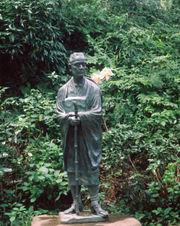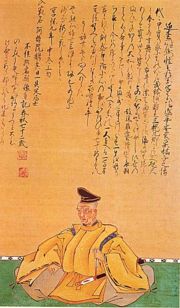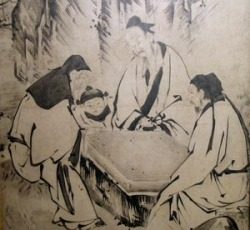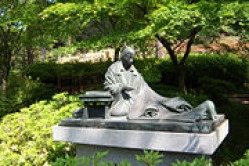Some Cultural Figures.....

Bashô (1644-1694)
Famous poet
Matsuo Bashô stands as one of the greatest - if not greatest - of Japan's haiku composers. A samurai turned wandering priest, Bashô wrote a book called 'Narrow Road of Oku' and many of his poems remain well-known in Japan - and around the world.
Chikamatsu (1653-1725)

Playwright
Chikamatsu Monzaemon, whose real name was Sugimori Nobumori, was born in NagatoProvince and into a minor samurai family. He was at first a monk, then returned to secular life and established himself at Osaka. Starting at around age 30, he would become one of Japan's most prolific and beloved playwrights, composing as many as 160 plays for the Kabuki and Bunraku (puppet) theatres. Many of his pieces were historically based and as many were on contemporary subjects that appealed to the common people. One of his favored devices was the tragic love between either a samurai or a townsman and a courtesan. In most of his plays, he presented a moral dillemna - the hero was presented with the confliction of duty and emotion - of what society expected and with what the hero felt in his heart. His most famous work was Chushingura, the story of the 47 Rônin. It may be that part of his ability came from the demands of writing for the Bunraku - he once commented that writing for that stage required him to make his dialogue as compelling and vivid as possible, given that, after all, the audience was looking at simple puppets.
Kano Eitoku (1543 - 1590)

Noted painter
Eitoku was the son of Kano Shôei (1514-1562) and carried on the Kano school of painting as established by Kano Masanobu (1434-1530). Eitoku was likely tutored at a young age by his talented grandfather Motonobu (1476-1559), who introduced him to shôgun Ashikaga Yoshiteru in 1552. In 1566 Eitoku produced a number of paintings for the Abbot's Quarters of the Jukônin in the Daitokuji. He was contracted by Oda Nobunaga to produce a series of wall paintings (shôhekiga) for AzuchiCastle around 1578 but these were all lost when Azuchi was destroyed in 1582. He afterwards worked for Toyotomi Hideyoshi and produced work for Juraku and OsakaCastle. Eitoku died suddenly in 1590 and his unfinished projects were completed by his son Mitsunobu. His most famous works included 'Chinese Lions', 'Flowers and Birds of the Four Seasons', and 'Scenes In and Around Kyoto' (a screen Nobunaga sent as a gift, along with 'Tale of Genji', to the eastern warlord Uesugi Kenshin in 1574). The last is useful to historians in picturing life in Kyoto in the mid-16th Century.
Murasaki Shikibu (???? - 1030?)

Famous novelist
Shikubu, or Lady Murasak, was the daughter of a certain Fujiwara Tametoki and married Fujiwara Nobutaka. Beyond educated conjecture, little is known of her early years. Her husband's death in 1001 marks the first date in her life history that can be assigned with any certainty. She seems to have retired to her home after Nobutaka's death and presumably began work on the her great work, the 'Tale of Genji'. Around 1005 her father arranged for her to become a lady-in-waiting to the consort of the Emperor Ichijô. Even here the details of her life remain obscure, despite her diary. We might assume that Shikibu accompanied the Empress of the late Ichijô (who died in 1011) into the latter's retirement at a detached palace but when she retired or died is unknown - she simply disappears from history after about 1525. Despite this fact, her novel 'The Tale of Genji' (Genji Monogatari) remains one of the world's literary milestones. This novel is believed to be the first example of what we today would describe as a novel.
